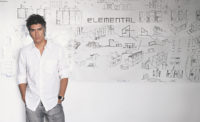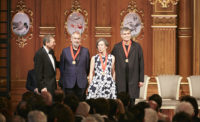Monday, the 2016 Pritzker architecture prize was formally awarded to Alejandro Aravena in a ceremony at the United Nations headquarters in New York. It was an appropriate setting for this year’s honor, as Aravena is known for creating a new model for low-cost housing in his native Chile. Guests at the Pritzker celebration—which included a reception in the spectacular curving lobby of the General Assembly building, followed by the ceremony in the Security Council Chamber, and dinner overlooking the East River—included fellow architects Thom Mayne, Tod Williams and Billie Tsien, Jeanne Gang, Richard Meier, Bjarke Ingels, Craig Dykers of Snøhetta, John Ronan, David Adjaye, Peter Eisenman, Francis Kere, Moshe Safdie, Odile Decq, Shigeru Ban, Steven Holl, Deborah Berke, Moshe Safdie, Brad Cloepfil, and Cesar Pelli.
A shadow over the evening’s festivities was the death last week of Zaha Hadid, who won the Pritzker in 2004. At the ceremony, Lord Peter Palumbo, the chair of the Pritzker jury and a longtime friend of Hadid’s, noted, her “role as a standard bearer for the equality of women and her staunch and unremitting opposition to prejudice in its many forms. “ She was “complicated, contrary and an utterly wonderful lady of indomitable spirit” he said, and relayed a telephone conversation he had with Hadid days before her fatal heart attack March 31: she jokingly told him in an East End accent: “Ain’t feeling too good today. Can’t manage them apples and pears” (Cockney rhyming slang for “stairs”).
Then Tom Pritzker, chair and president of the Hyatt Foundation, which bestows the prize, presented a medal to Aravena, (the award also comes with $100,000). In accepting Aravena explained that his firm, ELEMENTAL, was founded “as a Do Tank, not a Think Tank.” The architect said, “The power of architecture is to correct inequalities and improve the quality of life ” –and to do so “as a collective task” with many disciplines coming together. In vouching for the team process, he introduced his four partners in ELEMENTAL and thanked his wife and children for reminding him of the importance of every day life. He underscored his belief in a balanced life (“It’s an antidote to being too full of myself”), by recounting the emotional moment on a Saturday morning when he was at home with his family, and Pritzker executive director Martha Thorne called with the news that he had won the award.
The next evening, the Pritzker Prize and the UN’s Sustainable Development Goals Fund co-organized a panel discussion open to the public in UN Trusteeship Council Chamber. Moderated by Cathleen McGuigan, editor-in-chief of RECORD, the panel of Pritzker laureates responded to a question Aravena posed: What are the challenges ahead for the built environment? Richard Rogers, Glenn Murcutt, Christian de Portzamparc, Wang Shu, Renzo Piano, Jean Nouvel, and Aravena each came up with responses reflective of their particular work. Rogers worried that architects were becoming mere “decorators” adding, “We have to change the whole nature of the role of architecture” while Murcutt argued that social and religious prejudices posed the greatest challenge (he gave a moving description of his recent work designing a mosque in Australia). De Portzamparc spoke of the need to resist design that encourages enclaves and zones restricting interaction between different communities.
Aravena pointed out that the built environment is faced with the three S’s: “scale, speed, and scarcity, “which his work tries to mitigate. Wang Shu, addressing the tumultuous change in China, spoke of the importance of a sense of history, down to recycling materials from razed buildings. Piano advocated for the architect as “a civic poet,” and he encouraged the use of the “the pen you have in your hand, not computer simulation.” Murcutt agreed. “What is a city but a gallery of beautiful buildings? It’s not from handling the mouse—you need the eye-hand connection in order to think.” And when asked what subject architects should study besides their own discipline, Murcutt answered, “Biology. Nature is the greatest teacher.”















Post a comment to this article
Report Abusive Comment